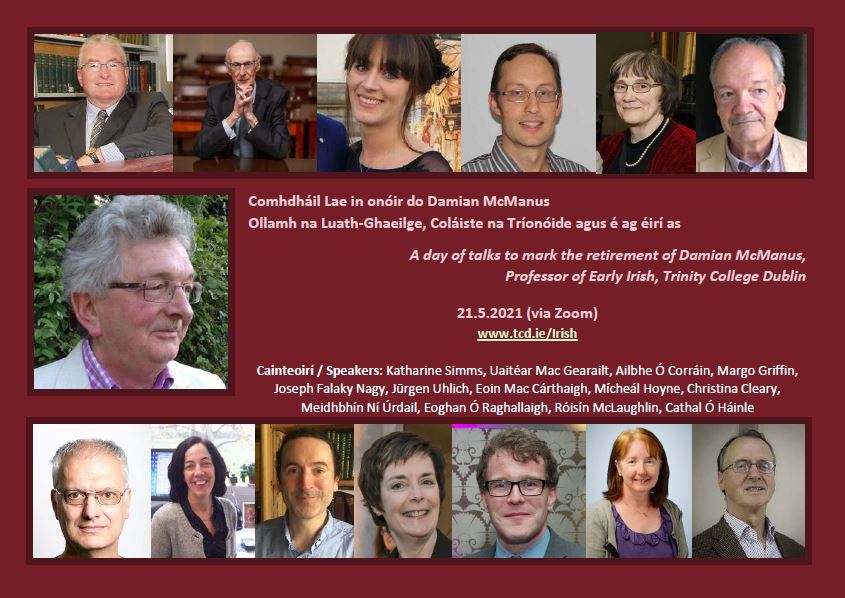Conference: A Day of Talks for Damian McManus - 21.5.2021
Fáilte
The Department of Irish and Celtic Studies, Trinity College, Dublin, are delighted to host a one-day online conference on the 21st May 2021. It wil be a day of talks to mark the retirement of Damian McManus, Professor of Early Irish, Trinity College Dublin. The conference will be run through both English and Irish.
Reáchtálfaidh Roinn na Gaeilge agus na dTeangacha Ceilteacha, Coláiste na Tríonóide, Baile Átha Cliath, comhdháil ar líne ar an 21ú Bealtaine 2021. Comhdháil lae in onóir do Damian McManus, Ollamh na Luath-Ghaeilge, Coláiste na Tríonóide, agus é ag éirí as. As Gaeilge agus as Béarla a bheidh na cainteanna.
Information
When? Friday 21 May 2021
Register here:
https://www.eventbrite.ie/e/comhdhail-lae-do-damian-mcmanus-a-day-of-talks-for-damian-mcmanus-tickets-149853825827
LINK TO ZOOM WEBINAR: https://tcd-ie.zoom.us/j/98353408003?pwd=MXE0V3FFR0M5K0JOdlNNZ3dSelhqdz09
The Conference will be launched at 9.20am
Speakers
- Katharine Simms
- Uáitéar Mac Gearailt
- Ailbhe Ó Corráin
- Margo Griffin
- Joseph Falaky Nagy
- Jürgen Uhlich (Handout on PDF here)
- Eoin Mac Cárthaigh
- Mícheál Hoyne
- Christina Cleary
- Meidhbhín Ní Úrdail
- Eoghan Ó Raghallaigh
- Róisín McLaughlin
- Cathal Ó Háinle
Full Schedule of the day's talks here (PDF).
An outline of the Speakers and their chosen topics
Contact
| nibhraoc@tcd.ie | |
| phone | +353 1 896 1450 |
| Instagram: | tcd_r_na_gaeilge |
| Twitter: | @TCDRnaGaeilge |
Speakers and Topics
Meidhbhín Ní Úrdail
Pádraig Ó Laoghaire (1870–1896): scoláire Gaeilge ó leithinis Bhéarra. Fé mar is léir ón teideal, scothbhualadh éadrom a thabharfad anseo do shaol agus do shaothar an scoláire Gaeilge Pádraig Ó Laoghaire (1870–1896) ó leithinis Bhéarra. D'fhoilsigh sé isteach is amach le leathchéad alt in irisí éagsúla Gaeilge ach is é an saothar is mó cáil óna pheann ná Sgeuluidheacht Chúige Mumhan. (1.) a foilsíodh in 1895. Ina ainneoin sin, duine is ea é a leogadh go mór i ndearmad, ní hamháin toisc go bhfuair sé bás i mbláth na hóige, ach toisc ról láir a bheith ag Laoghaireach eile ó Chúige Mumhan, an tAthair Peadar, i gConradh na Gaeilge. Tá gearrchuntas air ar an suíomh ainm.ie, ach ní féidir brath ar a bhfuil ansan mar go bhfuil fianaise bhreise aimsithe ó shin agam a bhréagnaíonn cuid mhaith dá bhfuil ann.
Eoin Mac Cárthaigh
For the birds: éanseanchas agus éanainmneacha i bhfilíocht na scol. Níl an t-uafás tagairtí don éanlaith sa dán díreach (filíocht shiollach ardréime na tréimhse 1200 go 1650) ach tá blas ar an mbeagán atá ann agus déanfar iniúchadh air sin sa pháipéar seo.
Eoghan Ó Raghallaigh
Roinnt dánta nua do chorpas fhilíocht na scol. Sa pháipéar seo, caithfear súil ar roinnt téacsanna de dhánta a tháinig chun solais ó rinneadh an phríomhobair thras-scríofa i gcomhair Thionscadal Fhilíocht na Scol faoi stiúir an Ollaimh McManus (https://www.tcd.ie/Irish/research/2000-2008-project.ga.php). Tá na dánta le cur ar fáil go gairid ar shuíomh gréasáin Bhunachar Fhilíocht na Scol (https://bardic.celt.dias.ie/).
Cathal Ó Háinle
An tIarla. An dán 'Ráinic a hanam Éire' a chum Fearghal Óg Mac an Bhaird d'Aodh Balldearg Ó Domhnaill thart ar 1690, tá sé ar maothas le dóchas gurb é Aodh a shaorfadh Éire ó ansmacht na nGall. Ina fhianaise sin, pléifidh mé an tslí ar iompair Aodh é féin ón uair a d'fhill sé abhaile ón Spáinn i mí Iúil 1690 go dtí gur fhág sé Éire arís i 1692.
Katharine Simms
Retiring Bards: the motives behind the professional bards' religious compositions. A discussion of the various reasons, whether devotional or mercenary, that might explain the high proportion of surviving bardic poems by secular professional praise-poets addressed to God or the saints or on general religious themes. It is argued that one cause might be the author's retirement to a monastery.
Ailbhe Ó Corráin
Slán agaibh a fhir chumtha, a poem by Giolla Brighde Ó hEódhasa. This poem, it will be argued, is suggestive of a fresh sensibility in Irish literature, an emergent subjectivity and a growing self-consciousness that can best be explained by reference to new ideas and in particular to a new ideal of love that emerged during the European renaissance of learning.
Margo Griffin-Wilson
A cup and a king: praise and artistry in Cuach ríogh Connacht, cuanna séad. This paper will examine the language, artistry and perspective in a bardic poem composed in praise of a drinking cup (cuach) in the possession of an Aodh Ó Conchobhair, king of Connacht. The poem is undated in the manuscript and seems to be incomplete; the poet is unnamed. Nevertheless, citations in the Irish Grammatical Tracts and the highly ornamented form of the metre rannaigheacht mhór suggest that it may have been composed sometime between 1200–1400. The poet extolls the cup as 'sea-wrack' (turchairthe), cast ashore from some unknown region and signifying a prosperous reign and a just and generous ruler. And yet, the figure of the king recedes into the background as the poet's gaze focuses on the crafted object, magnifying its exquisite ornamentation and life-like engravings. Lambert McKenna's edition (Aithdioghlaim Dána, no. 9) will provide the basic text for discussion, though textual details from the earliest manuscript witness (RIA MS 1387 (23 0 78)), which is not mentioned by McKenna, will also be considered in the analysis.
Mícheál Hoyne
Diúltadh céille: the historical present in the Classical Modern Irish linguistic tracts. Damian McManus, in one of his many contributions to our understanding and appreciation of the Bardic Grammatical and Syntactical Tracts, has described them as 'one of the finest achievements of Irish scholarship [...] deserving of the closest scrutiny' ('Classical Modern Irish', in K. McCone and K. Simms (eds), Progress in Medieval Irish Studies (Maynooth, 1996), 165–88, at p. 165). This paper will concentrate on a single aspect of these complex and detailed texts: how they describe the historical present (the present tense used in a narrative set in the past) and what this has to teach us about this syntactical phenomenon in Bardic poetry and the sophistication of contemporary Irish linguistics.
Joseph Falaky Nagy
A Skewered Champion. The talk focuses on the figure of Nad Crantail in TBC and his three-part encounter with Cú Chulainn. The latter's alighting on the sharpened stakes thrown at him by Nad Crantail, the evasive action taken to avoid the opponent's spear-cast, and Cú Chulainn's fortunate 'enfolding' of a pillar-stone are among the unusual details in this episode to be considered.
Uáitéar Mac Gearailt
Notes on the language of late Middle and Early Modern Irish translations from Latin. This paper will address language and dating issues in late translations of classical works, such as Togail na Téibe, In Cath Catharda, and Imtheachta Aeniasa. Salient linguistic features will be described and other prose works such as Beatha Aodha Ruaidh Uí Dhomhnaill will be considered in an attempt to identify commonalities that help to trace the development of prose writing in the early modern period.
Jürgen Uhlich
When did nd become nn in which Early Irish environments? Thurneysen (GOI §151 (c)) distinguishes between an Early Old Irish change nd > nn in proclitics and a Classical Old Irish one in stressed words. This paper argues that this is not sufficient and fails to account, in particular, for the different timing of the article ind > in(n). An additional problem is presented by nd and the comparable mb in Latin loan words, showing loss of the stop component e.g. in Secundinus yielding Sechnall and Columbanus Colmán (not *Colbán as expected by Thurneysen himself in 1933) but contradicted by scribendum at the basis of scríb(n)did 'scribe', with retention of -d-. It will be proposed that the first question can be resolved via a more detailed distinction of contexts between unstressed and/or stressed syllables, while the second reflects the chronology of treatment of nd etc. in British Latin.
Christina Cleary
Lock up your wives and daughters: Courtship rituals in Early Irish Literature. From a midnight visit while Moríath's mother is sleeping in Orgain Denna Ríg to the riddling dialogue in Tochmarc Emire to the grand display of finery as Fróech dramatically enters Ráth Crúachan, this paper will examine the different elements of the social ritual of courting in Early Irish literature. Leaving aside the commodification of marital unions, I will survey the motivations – other than being 'good-looking and irresistible' – for selecting a partner, descriptions and the effects of a lover's longing, the language used by prospective lovers, terms of endearment, and the settings for their unions.
Róisín McLaughlin
Dogs and Dragons as Readers' Aids in Irish Manuscripts. The purpose of this paper is to examine the design and development of the text run-over symbol, a scribal device which has received relatively little analysis to date. Aspects of the wider manuscript context and function of marginal art, the use of readers' aids and the relationship between text and image are also considered.


